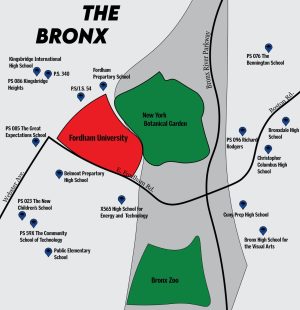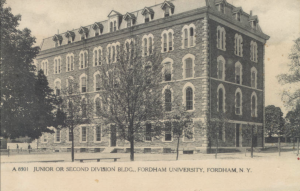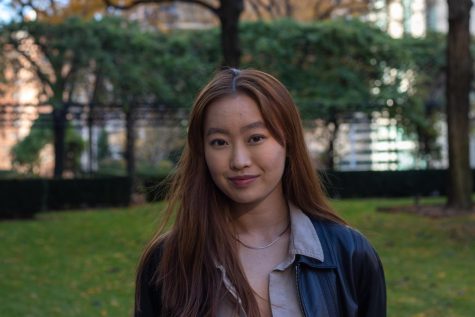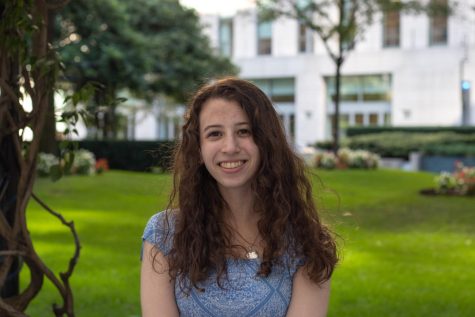(Almost) Everything You Need to Know About the Bronx
As students of Fordham Lincoln Center Students, we should educate ourselves and connect with the neighborhoods in which we are learning
Grab a bite to eat at Full Moon Pizzeria just a few blocks from campus!
April 28, 2022
“You go to Fordham? What’s it like in the Bronx?”
“Oh, no, I’m at the other campus, Lincoln Center.”
If you are a Fordham Lincoln Center student, chances are you’ve had an interaction like this before. While most of us believe that Lincoln Center is indeed the superior campus (better dorm views, better-dressed students), it is important to also understand the roots of our university and the neighborhoods it resides within.
The Bronx is an area with a long history and rich culture that all Fordham students, Lincoln Center and Rose Hill alike, should learn more about. A lot of us Lincoln Center students have taken one or multiple classes at Rose Hill or at least have commuted there via the Ram Van for an event. When we graduate, we will walk across the lawns of the Rose Hill campus, smiling proudly in front of the Gothic buildings with our caps and gowns.
No matter your major or your campus, all Fordham students are connected through one school and must understand our university’s history and relationship with the Bronx.
The Bronx in Numbers
The Bronx is one of the five boroughs of New York City. It is connected to Manhattan by numerous bridges and train tracks. An estimated 1.4 million people are currently living in the Bronx, with 56.4% of that population identifying as Hispanic. The second-largest ethnic group in the borough is Black or African American. Spanish is the most popular language other than English, with about 47.9% of the population being fluent speakers. Yoruba, Igbo and other West African languages are also very common, with about 42,000 speakers.
There is also a large immigrant population in the Bronx, with 35.7% of the population reported as being born outside of the United States in 2019. The majority of these foreign-born residents came from the Dominican Republic, China or Jamaica. In the same year, about 83.6% of the Bronx residents had American citizenship.
Weekends in the Bronx
While it’s hard to get bored as a college student in New York, the city’s weekend activities extend far beyond Manhattan. If you’re sick of Lower East Side nights that only ever end in sweat and tears and you’ve visited all the major museums around the borders of Central Park at least twice, it’s time to plan something in the Bronx for your friend group’s next outing.
The Fordham neighborhood in the Bronx is home to some of the must-see attractions that are definitely worth a trip in the much-too-slandered Ram Van. For starters, the Bronx Zoo is the largest zoo located in a major city in the U.S. Stop by to learn about the over 6,000 animals that live within those grounds. The Bronx Zoo is also deeply involved in conservation efforts. For example, conservationists at the zoo have helped reintroduce American bison to the natural grounds around New York.
Zoos aren’t really your thing? Fine, I get it, but you can’t turn down a visit to the New York Botanical Garden, just across the road from campus. How can you possibly justify graduating from Fordham without visiting once? Or twice or thrice or more.
For upperclassmen who are of age, you can even enjoy a few glasses of wine as you admire the nature around you.
Tickets are free for members of the Fordham community, and no two visits are the same with new exhibits every few months and different plants blooming in different seasons. Living next to Central Park is great and all, but it’s nothing compared to the Azalea Garden and Daffodil Valley at the Botanical Garden. For upperclassmen who are of age, you can even enjoy a few glasses of wine as you admire the nature around you.
Food in the Bronx
With so much diversity in the borough, it’s not surprising that the Bronx boasts some of the city’s most amazing food destinations. Just outside of Fordham Rose Hill’s campus gates is Arthur Avenue, home to authentic Italian food at prices that won’t destroy a college student’s bank account.
If you’re truly a Fordham student, you most likely despise the on-campus dining options and want to take advantage of eating off campus. For some quality olive oil, fresh cold cuts, imported cheeses and even a good shot of espresso, stop by Tino’s Delicatessen, a five-minute walk from campus. And if you want to treat yourself to something more than dollar pizza, visit the many Italian pizza joints on Arthur Ave, including Zero Otto Nove.
The South Bronx is also the home of many soul food restaurants like Sam’s Soul Food, Paula’s Soul Food Cafe and Amy Ruth’s, all of which are places where you can get delicious seasoned chicken at a reasonable price. Plus, eating at these restaurants will support small businesses owned by people of color.
New York is our campus, sure, but that does not mean it is merely our playground.
Travel 20 minutes east of Fordham Rose Hill, and you’ll find yourself on City Island, a small area connected to the Bronx and a place with some of the freshest seafood in all of New York. Once again, you can support local businesses and get to know this diverse neighborhood by indulging in lobster at City Island Lobster House, trying not to break a nail at The Original Crab Shanty or choosing between the fried and steamed sections of the cafeteria-style restaurant Johnny’s Reef.
Despite being home to a large collection of delicious restaurants, the Bronx also experiences the most food insecurity out of the five boroughs of New York City. Food security refers to safe and affordable food that is also easily accessible; recent reports have shown that food security only decreased since the start of the pandemic. Long-term health issues like diabetes are just one of the many consequences for residents who are subjected to areas of food insecurity.
Shopping at small businesses may help a few families, but there are also lots of nonprofit organizations that you could consider getting involved with. The possibilities range from volunteering for Hunger Free America to participating in Fordham’s very own Urban Plunge program.
Discrimination in the Bronx
Food and attractions aside, the Bronx is a borough that is subjected to extensive systemic injustices. Like any city and neighborhood in the United States, racism, classism and many other discriminatory practices are far too common, especially in a racially diverse area like the Bronx. It would take several, if not dozens, of entirely separate articles to even begin to address all the issues that residents of the Bronx face, but here is an introduction.
To begin, earlier this year, a deadly fire in an apartment building near Fordham’s campus killed 19 residents. Journalists have spoken out that this was no accident but the consequence of careless handling of housing safety in low-income neighborhoods. The fire was caused by a space heater, something that was necessary due to the inadequate heating system in the apartment building. It was spread by a faulty door that failed to close automatically, which is illegal in New York City.
The New Yorker reported that many other residents in the building had the same faulty doors, a pattern that you would not see in apartment buildings in predominantly white and higher-income neighborhoods in Manhattan.
By learning about the Bronx, we also are able to become more mindful of how we take up space in communities where we are guests.
The Bronx also faces environmental racism, the practice in which environmental laws disregard the health of residents in communities that are mostly made up of people of color and people with lower incomes.
Environmental racism especially affects Black and brown neighborhoods, where there are more toxic waste facilities and other sites of industrial toxicity that pollute the air. This then leads to more cases of health issues like asthma, diabetes and other serious diseases that can even be deadly. In the South Bronx, where the population is predominantly Black and brown, children are twice as likely to be hospitalized for asthma than children in any other US neighborhood.
These two examples are just the tip of the iceberg. We as students at Fordham University have a responsibility to educate ourselves about the ongoings of the neighborhoods around us. A lot of us can afford a higher education here at Fordham while being protected from the fires, pollution, food deserts and more within the gates of our campus, whether it be Lincoln Center or Rose Hill. Our mere presence in the city is a privileged one. New York is our campus, sure, but that does not mean it is merely our playground.
It is a place that should allow ongoing education. By learning about the Bronx, we also are able to become more mindful of how we take up space in communities where we are guests. We owe it to local residents to be respectful of our surroundings and give back when we can to the neighborhoods that host us. Visiting and informing yourself about issues in the Bronx is a good place to start.

















